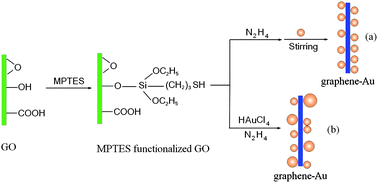Fabrication of hybrids based on graphene and metal nanoparticles by in situ and self-assembled methods
Abstract
In this work, we developed two novel strategies to attach metal

* Corresponding authors
a
Institute of Textiles and Clothing, The Hong Kong Polytechnic University, Hung Hom, Kowloon, Hong Kong
E-mail:
tcfanjt@inet.polyu.edu.hk
Fax: +852 2773 1432
b Key Laboratory for Designed Synthesis and Application of Polymer Materials, Sun Yat-Sen University, Guangzhou, China
c Department of Applied Physics and Materials Research Centre, The Hong Kong Polytechnic University, Hung Hom, Kowloon, Hong Kong
In this work, we developed two novel strategies to attach metal

 Please wait while we load your content...
Something went wrong. Try again?
Please wait while we load your content...
Something went wrong. Try again?
F. He, J. Fan, F. Song, L. Zhang and H. Lai-Wa Chan, Nanoscale, 2011, 3, 1182 DOI: 10.1039/C0NR00672F
To request permission to reproduce material from this article, please go to the Copyright Clearance Center request page.
If you are an author contributing to an RSC publication, you do not need to request permission provided correct acknowledgement is given.
If you are the author of this article, you do not need to request permission to reproduce figures and diagrams provided correct acknowledgement is given. If you want to reproduce the whole article in a third-party publication (excluding your thesis/dissertation for which permission is not required) please go to the Copyright Clearance Center request page.
Read more about how to correctly acknowledge RSC content.
 Fetching data from CrossRef.
Fetching data from CrossRef.
This may take some time to load.
Loading related content
